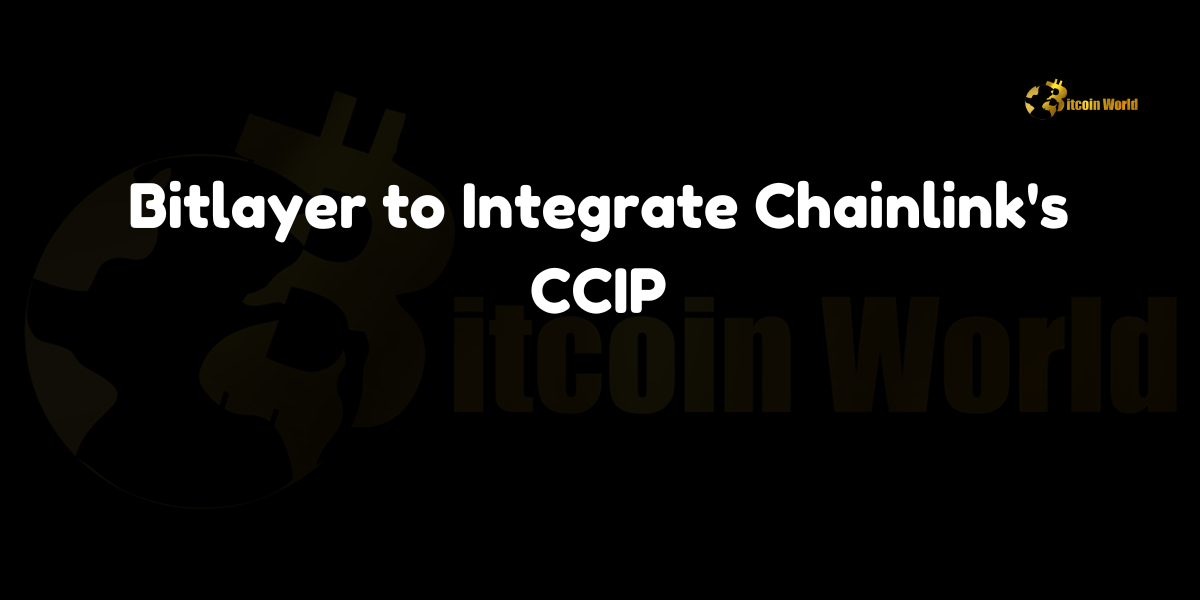Crptocurrency
Bitlayer to Integrate Chainlink’s CCIP

In a groundbreaking move to enhance cross-chain functionality and expand the decentralized finance (DeFi) ecosystem on Bitcoin, Bitlayer, a leading Bitcoin layer-2 network, announced in its official Medium blog that it will integrate Chainlink’s Cross-Chain Interoperability Protocol (CCIP) as its canonical cross-chain infrastructure. This strategic integration is set to empower Bitlayer developers to create seamless cross-chain applications, fostering greater interoperability and innovation within the Bitcoin network.
Introduction to Bitlayer and Chainlink’s CCIP
What is Bitlayer?
Bitlayer is an advanced layer-2 scaling solution for Bitcoin, designed to improve transaction speeds, reduce fees, and enable the development of decentralized applications (dApps) on the Bitcoin blockchain. By leveraging off-chain infrastructure and advanced cryptographic techniques, Bitlayer enhances Bitcoin’s scalability and functionality, positioning it as a robust platform for DeFi and other blockchain-based innovations.
Overview of Chainlink’s CCIP
Chainlink’s Cross-Chain Interoperability Protocol (CCIP) is a comprehensive protocol aimed at facilitating secure and reliable communication between different blockchain networks. CCIP enables the seamless transfer of data and value across chains, addressing one of the key challenges in the blockchain space: interoperability. By providing standardized tools and frameworks, CCIP allows developers to build cross-chain applications that can interact with multiple blockchains effortlessly.
Details of the Integration
Objectives of Integrating CCIP
The integration of Chainlink’s CCIP into Bitlayer serves several key objectives:
- Enhancing Interoperability: Enable Bitlayer to communicate and interact with other blockchain networks, expanding the scope and functionality of DeFi applications on Bitcoin.
- Facilitating Cross-Chain Transactions: Allow seamless transfer of assets and data between Bitcoin and other supported blockchains, enhancing liquidity and user experience.
- Promoting Developer Innovation: Provide Bitlayer developers with robust tools and protocols to create sophisticated cross-chain dApps, driving innovation within the Bitcoin ecosystem.
- Ensuring Security and Reliability: Leverage Chainlink’s proven security frameworks to ensure that cross-chain interactions are secure, transparent, and trustworthy.
Implementation Plan
Bitlayer plans to implement CCIP through the following steps:
- Technical Integration: Incorporate CCIP’s protocols into Bitlayer’s existing infrastructure, ensuring compatibility and seamless functionality.
- Developer Onboarding: Provide comprehensive documentation and support to Bitlayer developers, facilitating the creation of cross-chain applications.
- Testing and Deployment: Conduct extensive testing to ensure the reliability and security of the integrated protocols before full-scale deployment.
- Community Engagement: Engage with the Bitlayer and Chainlink communities to gather feedback, address concerns, and promote the benefits of cross-chain interoperability.
Benefits of the Integration
Enhanced Cross-Chain Functionality
By integrating CCIP, Bitlayer significantly enhances its cross-chain capabilities, allowing dApps on the Bitcoin network to interact with other blockchain platforms. This interoperability opens up new avenues for innovation, enabling the development of multi-chain DeFi applications, cross-chain asset swaps, and more.
Expanded DeFi Ecosystem on Bitcoin
The integration fosters a more vibrant and diverse DeFi ecosystem on Bitcoin by enabling access to a wider range of financial instruments and services. Users can leverage the strengths of multiple blockchains, such as Ethereum’s robust smart contract capabilities and Binance Smart Chain’s high throughput, within the Bitcoin-centric DeFi landscape.
Improved Liquidity and Asset Utilization
Cross-chain interoperability facilitated by CCIP allows for the efficient movement of assets across different networks, improving liquidity and asset utilization. This seamless transfer of value reduces friction in the market, enabling more dynamic and responsive DeFi applications.
Strengthened Security and Trust
Leveraging Chainlink’s reputable security protocols ensures that cross-chain interactions are conducted in a secure and reliable manner. This trust is crucial for attracting institutional investors and fostering widespread adoption of DeFi applications on Bitcoin.
Implications for the Bitcoin and Blockchain Ecosystem
Boosting Bitcoin’s Competitiveness
The integration of CCIP positions Bitlayer as a more competitive and versatile layer-2 solution for Bitcoin. Enhanced interoperability and cross-chain functionality attract more developers and projects to the Bitcoin network, strengthening its position as a leading platform for decentralized applications.
Driving Blockchain Innovation
By enabling seamless cross-chain interactions, CCIP encourages blockchain innovation by allowing developers to combine the unique features of different blockchains. This synergy fosters the creation of more sophisticated and feature-rich dApps, pushing the boundaries of what is possible within the decentralized ecosystem.
Promoting a Unified Blockchain Ecosystem
The collaboration between Bitlayer and Chainlink exemplifies the trend towards a more unified and interconnected blockchain ecosystem. As more protocols and networks adopt interoperability solutions, the fragmentation of the blockchain space diminishes, paving the way for a more cohesive and collaborative digital infrastructure.
Expert Opinions
Dr. Emily Carter, Blockchain Analyst
“The integration of Chainlink’s CCIP into Bitlayer is a significant step forward for the Bitcoin ecosystem. It not only enhances interoperability but also empowers developers to build more innovative and robust DeFi applications. This collaboration highlights the importance of cross-chain solutions in driving the future of decentralized finance.”
Mark Thompson, Financial Strategist
“Bitlayer’s adoption of Chainlink’s CCIP underscores the critical role of interoperability in the blockchain space. By enabling seamless cross-chain interactions, Bitlayer is positioning itself as a versatile and forward-thinking layer-2 solution, which is essential for the continued growth and adoption of DeFi on Bitcoin.”
Sarah Lee, Cryptocurrency Researcher
“Chainlink’s CCIP provides the necessary tools for Bitlayer to unlock new possibilities within the Bitcoin network. This integration not only enhances the functionality of DeFi applications but also fosters a more interconnected blockchain ecosystem, which is vital for the long-term sustainability and innovation of decentralized technologies.”
Future Outlook
Expansion of Cross-Chain Applications
With the successful integration of CCIP, Bitlayer is poised to expand its range of cross-chain applications. Future developments may include advanced DeFi protocols, cross-chain lending and borrowing platforms, and multi-chain NFT marketplaces, all of which will leverage the enhanced interoperability provided by CCIP.
Strengthening Partnerships and Collaborations
Bitlayer is likely to continue forging strategic partnerships with other blockchain projects and protocols to further enhance its cross-chain capabilities. Collaborations with leading DeFi platforms, NFT marketplaces, and enterprise blockchain solutions will drive the adoption and utility of Bitlayer’s layer-2 network.
Continuous Improvement and Innovation
As the blockchain landscape evolves, Bitlayer and Chainlink will focus on continuous improvement and innovation to stay ahead of emerging trends and technological advancements. This commitment ensures that Bitlayer remains at the forefront of layer-2 solutions, providing cutting-edge tools and protocols for developers and users alike.
Regulatory and Compliance Considerations
Navigating the complex regulatory environment is crucial for the sustained growth of cross-chain solutions. Bitlayer and Chainlink will work closely with regulatory bodies to ensure that their protocols comply with international standards, promoting transparency and trust within the blockchain ecosystem.
Conclusion
The integration of Chainlink’s Cross-Chain Interoperability Protocol (CCIP) into Bitlayer’s layer-2 network marks a pivotal advancement in the pursuit of enhanced interoperability and innovation within the Bitcoin ecosystem. By enabling seamless cross-chain interactions, this collaboration empowers developers to create more sophisticated and versatile DeFi applications, driving the growth and adoption of decentralized finance on Bitcoin.
As Bitlayer continues to expand its cross-chain capabilities and foster a more interconnected blockchain environment, the partnership with Chainlink sets the stage for a new era of blockchain innovation and collaboration. Investors, developers, and users can look forward to a more dynamic and resilient DeFi landscape, underpinned by robust interoperability solutions that bridge the gaps between different blockchain networks.
To stay updated on the latest developments in cross-chain interoperability and blockchain innovations, explore our article on latest news, where we cover significant events and their impact on the digital asset ecosystem.
Disclaimer: The information provided is not trading advice, Bitcoinworld.co.in holds no liability for any investments made based on the information provided on this page. We strongly recommend independent research and/or consultation with a qualified professional before making any investment decisions.
Crptocurrency
Ethereum Revenue Boost Expected as Layer-2 Activity Surges

Ethereum Revenue Boost Expected as Layer-2 Activity Surges
Ethereum’s network revenue is poised for a significant revival, driven by the rapid expansion of Layer-2 (L2) networks. In November 2024, L2 solutions like Base, Scroll, and World Chain tripled the transaction data posted to Ethereum’s mainnet compared to March, according to Dune Analytics. This surge in activity underscores the growing adoption of L2 technologies, which aim to increase Ethereum’s scalability and reduce costs, thereby enhancing the user experience and the blockchain’s overall ecosystem.
The boost in L2 network transactions comes at a critical time for Ethereum, as the network is recovering from the impact of the Dencun upgrade, implemented in March 2024. While the upgrade initially led to a notable drop in Ethereum’s revenue due to reduced transaction fees, the resurgence in activity through L2 networks is driving a revenue recovery. Matthew Sigel of VanEck projects that this trend could help Ethereum achieve $66 billion in annual cash flow by 2030, potentially driving the price of ETH up to $22,000. With renewed investor interest following the U.S. presidential election win of Donald Trump, which saw ETH prices rise 10%, Ethereum’s future looks promising as demand for efficient blockchain solutions continues to grow.
Understanding the Role of Layer-2 Networks in Ethereum’s Growth
Layer-2 solutions are scaling technologies built on top of Ethereum’s mainnet, enabling faster and more affordable transactions. By offloading some of the transaction load from the main Ethereum blockchain, these networks significantly reduce congestion and enhance transaction speeds. L2 networks have become a cornerstone of Ethereum’s strategy to address the scalability issues that have long hindered its growth and adoption.
The benefits of L2 networks go beyond speed and cost efficiency. They allow for more sophisticated applications to run on the blockchain, enabling use cases in decentralized finance (DeFi), gaming, and non-fungible tokens (NFTs). As the popularity of these applications increases, so does the demand for a scalable blockchain that can support high transaction volumes without compromising performance. With L2 solutions like Base, Scroll, and World Chain posting record transaction volumes, Ethereum’s scalability efforts appear to be paying off.
Ethereum’s Dencun Upgrade: A Double-Edged Sword
The Dencun upgrade, deployed in March 2024, introduced a range of improvements aimed at enhancing Ethereum’s efficiency and reducing transaction fees. However, these changes initially led to a drop in Ethereum’s network revenue, as transaction fees constitute a substantial portion of its earnings. Lower fees, while beneficial for users, resulted in a temporary revenue slump for the network.
Now, as L2 solutions drive transaction volumes back up, Ethereum is beginning to recover from this initial setback. The combined effect of lower fees and increased transaction volumes could yield a more sustainable revenue model, balancing affordability for users with profitability for the network. As L2 adoption accelerates, Ethereum’s revenue model could shift towards one that prioritizes transaction volume over fee structure, a change that would align well with the broader goals of blockchain scalability and accessibility.
Projected Revenue and Market Value: What’s Next for Ethereum?
The increased activity on Ethereum’s L2 networks has sparked renewed optimism among investors and analysts. According to VanEck’s Matthew Sigel, Ethereum’s annual cash flow could reach an impressive $66 billion by 2030. This projection assumes continued adoption of L2 solutions, as well as the sustained growth of decentralized applications (dApps) and DeFi platforms. Sigel’s analysis also indicates that this increased revenue potential could drive the price of ETH to approximately $22,000 over the next six years.
These projections reflect Ethereum’s potential to become a dominant force in the blockchain space, particularly as the network transitions to a more scalable and efficient model. For investors, Ethereum’s future revenue potential represents an opportunity to capitalize on the platform’s growth, as the blockchain continues to establish itself as the backbone of the decentralized internet.
The Impact of the U.S. Presidential Election on Ethereum and Crypto Markets
The recent U.S. presidential election, which saw Donald Trump winning a second term, has had a notable impact on the crypto market. Following the election, ETH prices surged by 10%, with Ether-based ETFs in the U.S. witnessing $52.3 million in net inflows. This trend suggests a renewed interest in cryptocurrency investments, as investors seek alternatives to traditional assets amid potential economic uncertainty.
Trump’s re-election has led to speculation around potential changes in regulatory policies that could either support or hinder the growth of the crypto industry. For Ethereum and other major cryptocurrencies, a more favorable regulatory environment could lead to increased institutional adoption, driving demand and potentially pushing prices higher. Conversely, restrictive policies could create challenges for the industry, though the resilience of blockchain technology and decentralized finance would likely persist.
The influx of investment into U.S. spot Ether ETFs highlights a shift in investor sentiment, with many viewing cryptocurrencies as a viable long-term asset class. This renewed interest in Ethereum and the broader crypto market signals a growing recognition of digital assets as an integral part of modern finance.
Challenges and Opportunities Ahead for Ethereum
While the outlook for Ethereum appears promising, several challenges remain. Scalability, security, and regulatory concerns continue to pose risks to the network’s growth. Although L2 solutions offer a temporary fix for scalability, further upgrades and innovations will be needed to sustain long-term growth. The Ethereum community is actively working on future updates to address these issues, including the anticipated “Shard Chains” upgrade, which aims to further enhance Ethereum’s scalability by splitting the blockchain into multiple “shards” that can process transactions in parallel.
In addition to technical challenges, Ethereum faces increasing competition from other blockchain networks that offer similar functionality with potentially greater scalability or lower fees. Projects like Solana, Polkadot, and Cardano are rapidly evolving and could pose a threat to Ethereum’s dominance in the smart contract and dApp ecosystem. However, Ethereum’s first-mover advantage, combined with its active developer community and widespread adoption, provides it with a strong foundation to maintain its position in the market.
Conclusion
Ethereum’s projected revenue growth, driven by the surge in Layer-2 network activity, paints an optimistic picture for the blockchain’s future. As L2 networks like Base, Scroll, and World Chain drive up transaction volumes, Ethereum is beginning to recover from the revenue slump experienced post-Dencun upgrade. With projections of $66 billion in annual cash flow by 2030 and a potential ETH price of $22,000, Ethereum is positioning itself as a key player in the evolving digital economy.
The recent spike in ETH prices following the U.S. presidential election and the inflow of funds into Ether ETFs underscore the growing interest in crypto assets as viable investments. However, Ethereum must navigate several challenges, including scalability and competition, to maintain its growth trajectory. As the Ethereum network continues to evolve and adapt to the demands of a rapidly changing landscape, it has the potential to redefine the future of decentralized finance and the broader blockchain industry.
To learn more about the innovative startups shaping the future of the crypto industry, explore our article on the latest news, where we delve into the most promising ventures and their potential to disrupt traditional industries.
Crptocurrency
Invest $500 in These High-Growth Altcoins and Secure a $2 Million Crypto Portfolio by 2025

Crptocurrency
Fed Cuts Interest Rate by 25 Basis Points, Aligns with Market Predictions

-

 Startup Stories1 year ago
Startup Stories1 year agoWhy Millennials, GenZs Are Riding The Investment Tech Wave In India
-

 Startup Stories1 year ago
Startup Stories1 year agoStartups That Caught Our Eyes In September 2023
-

 Startup Stories1 year ago
Startup Stories1 year agoHow Raaho Is Using Tech To Transform India’s Fragmented Commercial Trucking
-

 Startup Stories1 year ago
Startup Stories1 year agoMeet The 10 Indian Startup Gems In The Indian Jewellery Industry’s Crown
-

 Crptocurrency8 months ago
Crptocurrency8 months agoLither is Making Crypto Safe, Fun, and Profitable for Everyone!
-

 Startup Stories1 year ago
Startup Stories1 year agoHow Volt Money Is Unlocking The Value Of Mutual Funds With Secured Lending
-

 E-commerce1 year ago
E-commerce1 year agoTop Online Couponing Trends To Watch Out For In 2016
-

 Startup Stories1 year ago
Startup Stories1 year agoWhy Moscow-Based Kladana Considers Indian SME Sector As The Next Big Market For Cloud Computing




